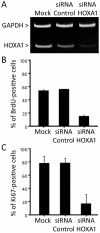HOXA1 is overexpressed in oral squamous cell carcinomas and its expression is correlated with poor prognosis
- PMID: 22498108
- PMCID: PMC3351375
- DOI: 10.1186/1471-2407-12-146
HOXA1 is overexpressed in oral squamous cell carcinomas and its expression is correlated with poor prognosis
Abstract
Background: HOX genes encode homeodomain-containing transcription factors involved in the regulation of cellular proliferation and differentiation during embryogenesis. However, members of this family demonstrated oncogenic properties in some malignancies. The present study investigated whether genes of the HOXA cluster play a role in oral cancer.
Methods: In order to identify differentially expressed HOXA genes, duplex RT-PCR in oral samples from healthy mucosa and squamous cell carcinoma was used. The effects of HOXA1 on proliferation, apoptosis, adhesion, invasion, epithelial-mesenchymal transition (EMT) and anchorage-independent growth were assessed in cells with up- and down-regulation of HOXA1. Immunohistochemical analysis using a tissue microarray (TMA) containing 127 oral squamous cell carcinomas (OSCC) was performed to determine the prognostic role of HOXA1 expression.
Results: We showed that transcripts of HOXA genes are more abundant in OSCC than in healthy oral mucosa. In particular, HOXA1, which has been described as one of the HOX members that plays an important role in tumorigenesis, was significantly more expressed in OSCCs compared to healthy oral mucosas. Further analysis demonstrated that overexpression of HOXA1 in HaCAT human epithelial cells promotes proliferation, whereas downregulation of HOXA1 in human OSCC cells (SCC9 cells) decreases it. Enforced HOXA1 expression in HaCAT cells was not capable of modulating other events related to tumorigenesis, including apoptosis, adhesion, invasion, EMT and anchorage-independent growth. A high number of HOXA1-positive cells was significantly associated with T stage, N stage, tumor differentiation and proliferative potential of the tumors, and was predictive of poor survival. In multivariate analysis, HOXA1 was an independent prognostic factor for OSCC patients (HR: 2.68; 95% CI: 1.59-2.97; p = 0.026).
Conclusion: Our findings indicate that HOXA1 may contribute to oral carcinogenesis by increasing tumor cell proliferation, and suggest that HOXA1 expression might be helpful as a prognostic marker for patients with OSCC.
Figures






References
-
- Hassan NM, Hamada J, Murai T, Seino A, Takahas'hi Y, Tada M, Zhang X, Kashiwazaki H, Yamazaki Y, Inoue N, Moriuchi T. Aberrant expression of HOX genes in oral dysplasia and squamous cell carcinoma tissues. Oncol Res. 2006;16(5):217–224. - PubMed
Publication types
MeSH terms
Substances
LinkOut - more resources
Full Text Sources
Medical

